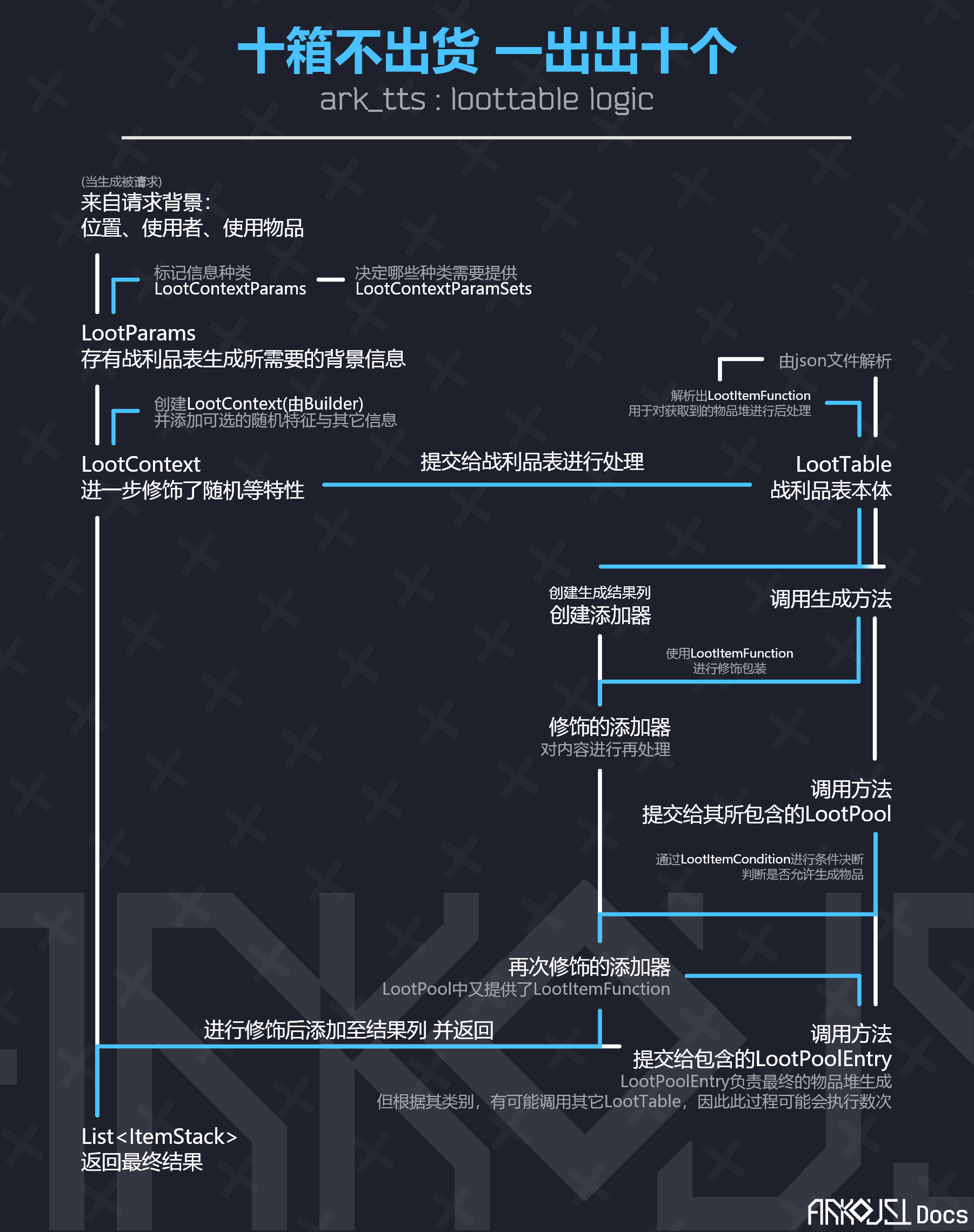战利品表
战利品表(LootTable)是在游戏中常见的,用于从一组物品堆(ItemStack)中随机或根据条件挑选某个物品堆的设计。 在游戏原版中,方块在不同情况下的掉落(例如矿石的正常挖掘与精准采集的区别),游戏中宝箱内容的生成,钓鱼或猫的礼物的决定都是由战利品表提供的。
本章节中不会过多的阐述战利品表的使用方法——这一篇的主要内容是如何为战利品表的json解析添加自定义的解析器。
战利品表的基本使用
战利品表以json文件形式,存储在data/[modid]/loot_tables下。对于不同的用途,通常也会在路径下再进行细分, 例如方块的掉落物就通常在路径下的blocks文件夹中,而箱子之类的物品随机生成在chests文件夹下。
在箱子一类的,实现了RandomizableContainer接口的类,可以使用setLootTable来设置其掉落物表;而对于具体的内容生成,需要参考对应的实现代码。 在该类中提供了默认方法用于便捷的处理生成:
default void unpackLootTable(@Nullable Player pPlayer) {
Level level = this.getLevel();
BlockPos blockpos = this.getBlockPos();
ResourceLocation resourcelocation = this.getLootTable();
if (resourcelocation != null && level != null && level.getServer() != null) {
LootTable loottable = level.getServer().getLootData().getLootTable(resourcelocation);
if (pPlayer instanceof ServerPlayer) {
CriteriaTriggers.GENERATE_LOOT.trigger((ServerPlayer) pPlayer, resourcelocation);
}
this.setLootTable(null);
LootParams.Builder lootparams$builder = new LootParams.Builder((ServerLevel) level)
.withParameter(LootContextParams.ORIGIN, Vec3.atCenterOf(blockpos));
if (pPlayer != null) {
lootparams$builder.withLuck(pPlayer.getLuck()).withParameter(LootContextParams.THIS_ENTITY, pPlayer);
}
loottable.fill(this, lootparams$builder.create(LootContextParamSets.CHEST), this.getLootTableSeed());
}
}而钓鱼竿,你可以在net.minecraft.world.entity.projectile.FishingHook#retrieve下看到其源码。这里节选部分内容:
static {
LootParams lootparams = new LootParams.Builder((ServerLevel) this.level())
.withParameter(LootContextParams.ORIGIN, this.position())
.withParameter(LootContextParams.TOOL, pStack)
.withParameter(LootContextParams.THIS_ENTITY, this)
.withParameter(LootContextParams.KILLER_ENTITY, this.getOwner())
.withLuck((float) this.luck + player.getLuck())
.create(LootContextParamSets.FISHING);
LootTable loottable = this.level().getServer().getLootData().getLootTable(BuiltInLootTables.FISHING);
List<ItemStack> list = loottable.getRandomItems(lootparams);
//...
for (ItemStack itemstack : list) {
ItemEntity itementity = new ItemEntity(this.level(), this.getX(), this.getY(), this.getZ(), itemstack);
double d0 = player.getX() - this.getX();
double d1 = player.getY() - this.getY();
double d2 = player.getZ() - this.getZ();
double d3 = 0.1;
itementity.setDeltaMovement(d0 * 0.1, d1 * 0.1 + Math.sqrt(Math.sqrt(d0 * d0 + d1 * d1 + d2 * d2)) * 0.08, d2 * 0.1);
this.level().addFreshEntity(itementity);
player.level()
.addFreshEntity(new ExperienceOrb(player.level(), player.getX(), player.getY() + 0.5, player.getZ() + 0.5, this.random.nextInt(6) + 1));
if (itemstack.is(ItemTags.FISHES)) {
player.awardStat(Stats.FISH_CAUGHT, 1);
}
}
}LootTable的有关类
让我们从最浅层说起:在上面的代码中,我们不难看到,有LootParams和LootTable两个类被使用。
交互层:LootParams与LootTable
我们先来看LootParams:
LootParams lootparams = new LootParams.Builder((ServerLevel) this.level())
.withParameter(LootContextParams.ORIGIN, this.position())
.withParameter(LootContextParams.TOOL, pStack)
.withParameter(LootContextParams.THIS_ENTITY, this)
.withParameter(LootContextParams.KILLER_ENTITY, this.getOwner())
.withLuck((float) this.luck + player.getLuck())
.create(LootContextParamSets.FISHING);不难看出,LootParams类的用途就是为战利品生成提供触发条件信息。
在这里,LootContextParams类下指定了该信息的种类,withParameter方法将一个种类与数据绑定, 这里配置了位置(ORIGIN),使用的物品堆(TOOL),主语实体(THIS_ENTITY)与宾语实体(KILLER_ENTITY),还额外配置了幸运属性。 最后调用了create方法完成了构造。
这里传入的LootContextParamSets中指定了请求的内容种类,我们可以来略微看一下:
public static final LootContextParamSet FISHING = register(
"fishing", builder -> builder.required(LootContextParams.ORIGIN)
.required(LootContextParams.TOOL) //要求 工具
.optional(LootContextParams.THIS_ENTITY) //可选 主语实体 没看错的话似乎是那个浮标
.required(LootContextParams.KILLER_ENTITY) //Forge: Add the fisher as a killer.
);然后是LootTable,这其实是把我们的战利品表的json文件解析为了实例。从注册表中获取到实例,然后使用getRandomItems方法获取一组生成物。 对于钓鱼内容的战利品表,这通常只会生成一个物品堆。
在这个方法中,LootParams又被进一步修饰,添加随机特征(在战利品表中配置,可选),转化为LootContext即战利品背景, 其builder内还有一些可选的配置内容,但在这里都没有被使用到。
结构层:LootItemCondition,LootPoolEntryContainer与LootItemFunction
让我们继续来深入探究LootTable内的内容,看看物品是怎么从中通过各种条件生成的。
先来聊聊其生成逻辑:在收到生成请求后,程序会创建一个物品堆添加器(呃,Consumer<ItemStack>) 用于向结果表中添加需要产出的物品。 ,然后对添加器进行二次包装,使用保有的LootItemFunction 进行修饰,最后发布给所有战利品池,也就是LootPool。
在LootPool中,逻辑将会通过条件决断(由LootItemCondition负责),决断通过后将会发布给其所包含的LootPoolEntryContainer 请求物品。 由于LootPoolEntryContainer仍有可能指向其它战利品表,这一过程可能会循环执行几次。
这一张图片可以帮助我们理解:
其中,LootItemCondition,LootPoolEntryContainer与LootItemFunction这三种内容均可以自定义:
LootPoolEntryContainer用于生成战利品结果,需要LootPoolEntryType(见BuiltInRegistries.LOOT_POOL_ENTRY_TYPE) 来标记类型,同时实现void createItemStack(Consumer<ItemStack> pStackConsumer, LootContext pLootContext)方法, 用于添加未修饰的结果物品堆。LootItemCondition用于决断战利品条件,需要LootItemConditionType(见BuiltInRegistries.LOOT_CONDITION_TYPE) 来标记类型,同时实现boolean test(LootContext pContext)方法,用于判断此背景下生成条件是否成立。LootItemFunction用于修饰结果物品堆。需要LootItemFunctionType(见BuiltInRegistries.LOOT_FUNCTION_TYPE) 来标记类型,同时实现ItemStack run(ItemStack pStack, LootContext pContext)方法,用于对已确定的物品堆进行修饰处理。
注册实例
上述三种可自定义的类的注册,均需要使用其对应的Codec完成。这里我们给出一个LootPoolEntry的范例:
//假定我们现在有两种使用forge注册系统的自定义类:Material与MaterialItemType:
public class LootMaterialItem extends LootPoolSingletonContainer {
//创建我们的codec。codec可以负责json信息与实例的相互转化
public static final Codec<LootMaterialItem> CODEC = RecordCodecBuilder.create(ins -> ins.group(
Registry$Material.MATERIAL.holderByNameCodec().fieldOf("material").forGetter(i -> i.materialHolder),//存储Material信息。注意这里的Material是我们自定义的注册类,原版没有
Registry$Material.MATERIAL_ITEM_TYPE.holderByNameCodec().fieldOf("material_type").forGetter(i -> i.typeHolder))//存储MaterialItemType/信息。同上
.and(singletonFields(ins))//将内容合并。调用的方法由父类提供,负责解析权重与其它修饰内容
.apply(ins, LootMaterialItem::new)
) ;
private final Holder<Material> materialHolder;
private final Holder<MaterialItemType> typeHolder;
protected LootMaterialItem(Holder<Material> materialHolder, Holder<MaterialItemType> typeHolder, int pWeight, int pQuality, List<LootItemCondition> pConditions, List<LootItemFunction> pFunctions) {
super(pWeight, pQuality, pConditions, pFunctions);
this.materialHolder = materialHolder;
this.typeHolder = typeHolder;
}
//实现createItemStack方法,允许我们在前置条件允许的情况下,返回一个或多个物品堆
@Override
protected void createItemStack(Consumer<ItemStack> pStackConsumer, LootContext pLootContext) {
pStackConsumer.accept(System$Material.getFromMAndMIT(materialHolder.value(), typeHolder.value()));//通过特定方法,将我们的Material与MaterialItemType转化为物品堆
// pStackConsumer.accept([其他的物品堆]);//如果需要返回多个物品堆,多次调用consumer即可
}
//返回我们注册的类型
@Override
public @NotNull LootPoolEntryType getType() {
return CodecReg.MATERIAL_ITEM_LOOT_POOL.get();
}
}
//注册部分
public class CodecReg {
//创建LootPoolEntryType的注册器。别忘了在mod主类中将其注册至IModEventBus!
public static final DeferredRegister<LootPoolEntryType> LOOT_POOL = DeferredRegister.create(Registries.LOOT_POOL_ENTRY_TYPE, BreakdownCore.MODID);
//注册我们刚刚创建的LootPoolSingletonContainer子类。这一内容可以在getType方法里使用。
public static final DeferredHolder<LootPoolEntryType, LootPoolEntryType> MATERIAL_ITEM_LOOT_POOL = LOOT_POOL.register("material_item", () -> new LootPoolEntryType(LootMaterialItem.CODEC));
}这样,只需在你的loottable对应位置将type设定为你注册的id,你就可以使用自定义的LootPoolEntry了。